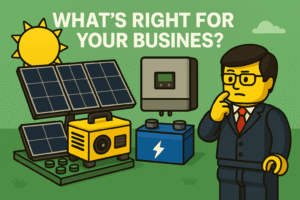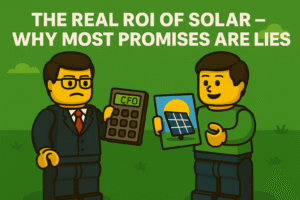Here’s The Illusion Most Buyers Believe
When a solar installer tells you:
“Your batteries will last 10 years.”
Here’s what they don’t say:
- That “10 years” assumes ideal conditions you’ll never meet.
- It’s based on cycle counts, not calendar years.
- And it ignores the fact that battery performance degrades long before warranty ends.
The result? Businesses budgeting for one replacement cycle end up buying batteries twice — killing their ROI.
The 3 Questions You Must Ask About Batteries
- What’s the Chemistry?
- Lithium Iron Phosphate (LFP): Longer lifespan, safer, more stable.
- NMC / NCA: Higher energy density, but typically shorter lifespan.
- Lead Acid / Gel: Cheap upfront, expensive long-term.
If suppliers can’t explain chemistry trade-offs, they don’t deserve your business.
- What’s the Real Warranty?
Read the fine print:
- Is it cycles or years (whichever comes first)?
- Does it cover capacity loss (70–80% after X years) or just outright failure?
- Who backs the warranty — the installer or the manufacturer?
A warranty that only covers catastrophic failure is worthless.
- What’s the Degradation Profile?
Every battery loses capacity. The question is: how fast?
A 10kWh battery at 70% after 7 years is effectively a 7kWh battery.
If your system isn’t sized with degradation in mind, you’ll be underpowered when you need it most.
Where Businesses Get Burned
- Sizing too small: running batteries too deep kills them faster.
- No cooling/ventilation: heat destroys lifespan.
- Ignoring replacements in ROI models: the payback math becomes fiction.
A backup system is only as smart as its weakest battery.
If you treat batteries like a commodity, you’ll end up with a system that fails before the finance term is done.
When evaluating solar quotes, make batteries your first point of scrutiny.
Ask about chemistry, warranty, degradation — and get it in writing.
Let’s build your legacy Together
Book a free call to chat about where you need help


